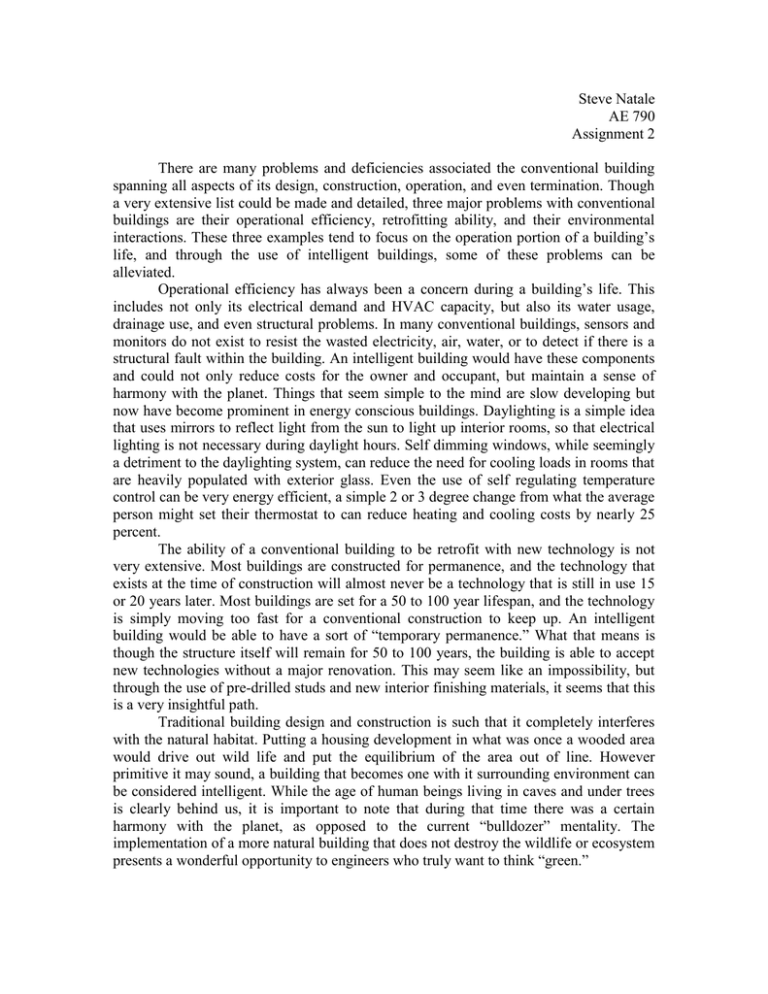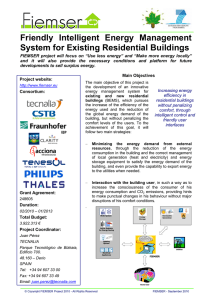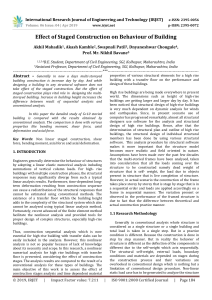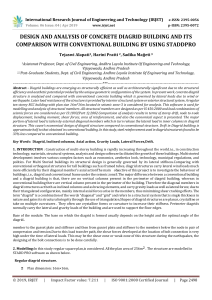Steve Natale AE 790 Assignment 2
advertisement

Steve Natale AE 790 Assignment 2 There are many problems and deficiencies associated the conventional building spanning all aspects of its design, construction, operation, and even termination. Though a very extensive list could be made and detailed, three major problems with conventional buildings are their operational efficiency, retrofitting ability, and their environmental interactions. These three examples tend to focus on the operation portion of a building’s life, and through the use of intelligent buildings, some of these problems can be alleviated. Operational efficiency has always been a concern during a building’s life. This includes not only its electrical demand and HVAC capacity, but also its water usage, drainage use, and even structural problems. In many conventional buildings, sensors and monitors do not exist to resist the wasted electricity, air, water, or to detect if there is a structural fault within the building. An intelligent building would have these components and could not only reduce costs for the owner and occupant, but maintain a sense of harmony with the planet. Things that seem simple to the mind are slow developing but now have become prominent in energy conscious buildings. Daylighting is a simple idea that uses mirrors to reflect light from the sun to light up interior rooms, so that electrical lighting is not necessary during daylight hours. Self dimming windows, while seemingly a detriment to the daylighting system, can reduce the need for cooling loads in rooms that are heavily populated with exterior glass. Even the use of self regulating temperature control can be very energy efficient, a simple 2 or 3 degree change from what the average person might set their thermostat to can reduce heating and cooling costs by nearly 25 percent. The ability of a conventional building to be retrofit with new technology is not very extensive. Most buildings are constructed for permanence, and the technology that exists at the time of construction will almost never be a technology that is still in use 15 or 20 years later. Most buildings are set for a 50 to 100 year lifespan, and the technology is simply moving too fast for a conventional construction to keep up. An intelligent building would be able to have a sort of “temporary permanence.” What that means is though the structure itself will remain for 50 to 100 years, the building is able to accept new technologies without a major renovation. This may seem like an impossibility, but through the use of pre-drilled studs and new interior finishing materials, it seems that this is a very insightful path. Traditional building design and construction is such that it completely interferes with the natural habitat. Putting a housing development in what was once a wooded area would drive out wild life and put the equilibrium of the area out of line. However primitive it may sound, a building that becomes one with it surrounding environment can be considered intelligent. While the age of human beings living in caves and under trees is clearly behind us, it is important to note that during that time there was a certain harmony with the planet, as opposed to the current “bulldozer” mentality. The implementation of a more natural building that does not destroy the wildlife or ecosystem presents a wonderful opportunity to engineers who truly want to think “green.”





